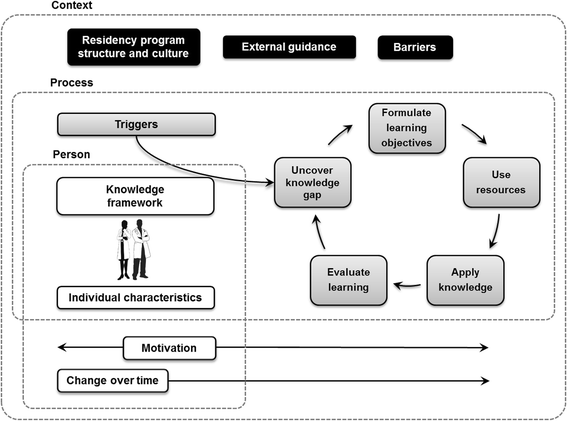A model of self-directed learning in internal medicine residency: a qualitative study using grounded theory
- PMID: 28148247
- PMCID: PMC5288975
- DOI: 10.1186/s12909-017-0869-4
A model of self-directed learning in internal medicine residency: a qualitative study using grounded theory
Abstract
Background: Existing theories of self-directed learning (SDL) have emphasized the importance of process, personal, and contextual factors. Previous medical education research has largely focused on the process of SDL. We explored the experience with and perception of SDL among internal medicine residents to gain understanding of the personal and contextual factors of SDL in graduate medical education.
Methods: Using a constructivist grounded theory approach, we conducted 7 focus group interviews with 46 internal medicine residents at an academic medical center. We processed the data by using open coding and writing analytic memos. Team members organized open codes to create axial codes, which were applied to all transcripts. Guided by a previous model of SDL, we developed a theoretical model that was revised through constant comparison with new data as they were collected, and we refined the theory until it had adequate explanatory power and was appropriately grounded in the experiences of residents.
Results: We developed a theoretical model of SDL to explain the process, personal, and contextual factors affecting SDL during residency training. The process of SDL began with a trigger that uncovered a knowledge gap. Residents progressed to formulating learning objectives, using resources, applying knowledge, and evaluating learning. Personal factors included motivations, individual characteristics, and the change in approach to SDL over time. Contextual factors included the need for external guidance, the influence of residency program structure and culture, and the presence of contextual barriers.
Conclusions: We developed a theoretical model of SDL in medical education that can be used to promote and assess resident SDL through understanding the process, person, and context of SDL.
Keywords: Adult learning theory; Graduate medical education; Self-directed learning.
Figures

Similar articles
-
Faculty Support for Self-Directed Learning in Internal Medicine Residency: A Qualitative Study Using Grounded Theory.Acad Med. 2018 Jun;93(6):943-951. doi: 10.1097/ACM.0000000000002077. Acad Med. 2018. PMID: 29210753
-
Struggling to be self-directed: residents' paradoxical beliefs about learning.Acad Med. 2011 Dec;86(12):1539-44. doi: 10.1097/ACM.0b013e3182359476. Acad Med. 2011. PMID: 22030764
-
Internal Medicine Residents' Perceptions of Team-Based Care and its Educational Value in the Continuity Clinic: A Qualitative Study.J Gen Intern Med. 2015 Sep;30(9):1279-85. doi: 10.1007/s11606-015-3228-3. J Gen Intern Med. 2015. PMID: 26173512 Free PMC article.
-
A blueprint for implementation of a structured portfolio in an internal medicine residency.Acad Med. 2012 Feb;87(2):185-91. doi: 10.1097/ACM.0b013e31823f40a2. Acad Med. 2012. PMID: 22189884 Review.
-
Advancing educational continuity in primary care residencies: an opportunity for patient-centered medical homes.Acad Med. 2015 May;90(5):587-93. doi: 10.1097/ACM.0000000000000589. Acad Med. 2015. PMID: 25470307 Review.
Cited by
-
Seeing the Other: How Residents Expand Their Perspective by Learning With the Arts.J Grad Med Educ. 2023 Feb;15(1):50-58. doi: 10.4300/JGME-D-22-00140.1. J Grad Med Educ. 2023. PMID: 36817544 Free PMC article.
-
A Mixed-Methods Program Evaluation of a Self-directed Learning Panel Management Curriculum in an Internal Medicine Residency Clinic.J Gen Intern Med. 2022 Jul;37(9):2246-2250. doi: 10.1007/s11606-022-07507-3. Epub 2022 Jun 16. J Gen Intern Med. 2022. PMID: 35710657 Free PMC article.
-
Some Learning Theories for Medical Educators.Med Sci Educ. 2021 Mar 22;31(3):1157-1172. doi: 10.1007/s40670-021-01270-6. eCollection 2021 Jun. Med Sci Educ. 2021. PMID: 34457959 Free PMC article.
-
A story half told: a qualitative study of medical students' self-directed learning in the clinical setting.BMC Med Educ. 2021 Sep 15;21(1):494. doi: 10.1186/s12909-021-02913-3. BMC Med Educ. 2021. PMID: 34525997 Free PMC article.
-
Barriers and enablers to achieving clinical procedure competency-based outcomes in a national paediatric training/residency program-a multi-centered qualitative study.BMC Med Educ. 2023 Dec 13;23(1):954. doi: 10.1186/s12909-023-04928-4. BMC Med Educ. 2023. PMID: 38093268 Free PMC article.
References
-
- Accreditation Council for Graduate Medical Education (2016). Common program requirements. [cited 2017 Jan 26.] Available from: https://www.acgme.org/Portals/0/PFAssets/ProgramRequirements/CPRs_070120....
-
- Brockett RG, Donaghy RC. Self-directed learning: the houle connection. Int J Self Direct Learn. 2011;8(2):1–10.
-
- Knowles MS, Holton EF, III, Swanson RA. The adult learner: the definitive classic in adult education and human resource development. 6. Boston (MA): Elsevier/Butterworth Heinemann; 2005.
MeSH terms
Grants and funding
LinkOut - more resources
Full Text Sources
Other Literature Sources
Miscellaneous

